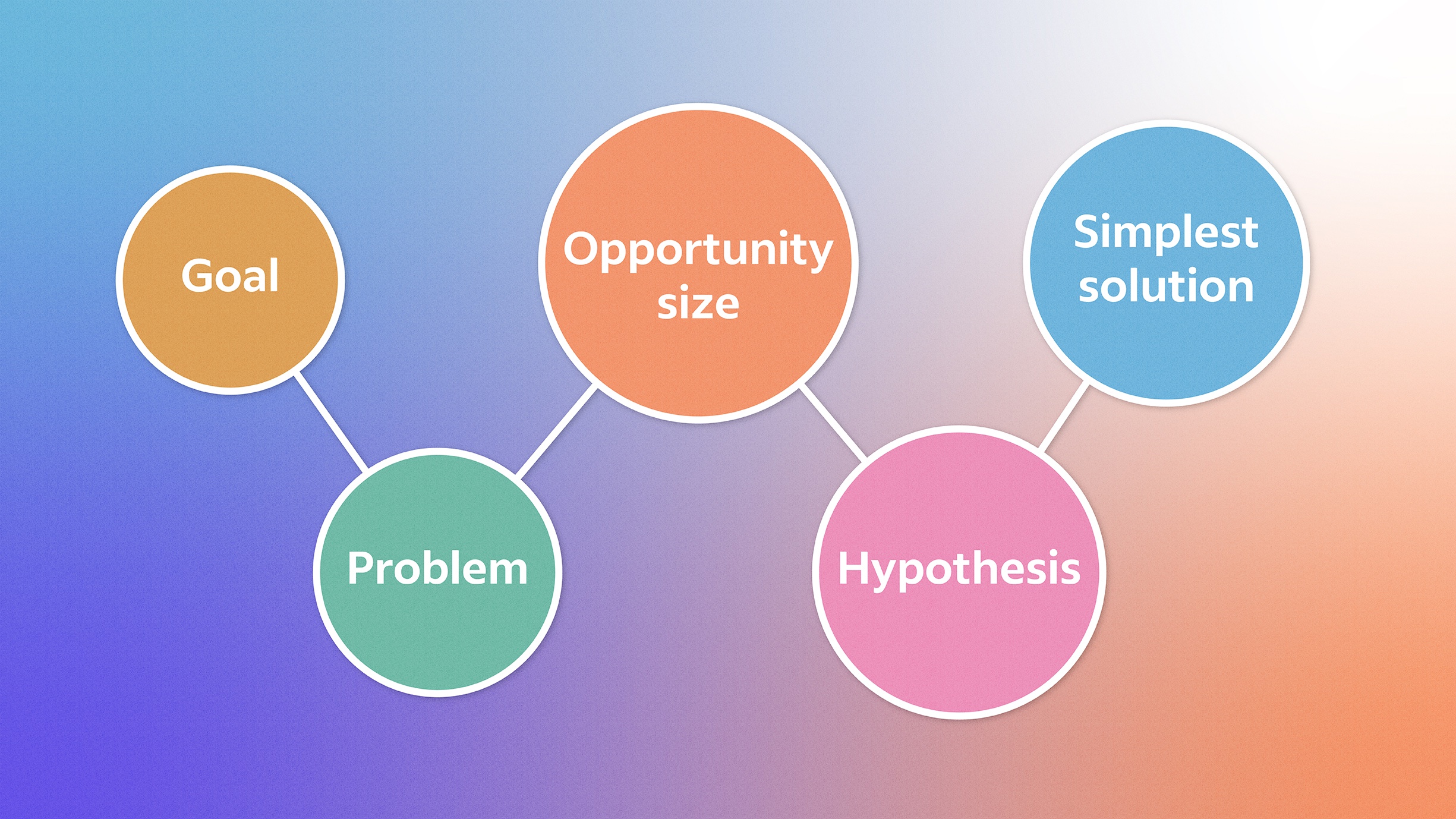Spoiler. I’m not a product manager. I’m a content designer. One with obviously brilliant ideas, which were often ignored by decision-makers—the PMs.
Not long into my role, I began to question what I was doing wrong (and if my ideas were actually brilliant to begin with). I needed to know how PMs decided to pursue one idea over another so I could better prepare my pitch to them. I’m still learning.
In this pursuit, I’m having more strategic conversations with PMs, helping to drive product vision, and wasting less time on design ideas with no chance of making it into the backlog.
If you find yourself frustrated by constant incremental improvements and feel your UX ideas are not taken seriously, look at how product teams operate and how you can be more effective within them. When we adopt a product mindset, designers can graduate from stakeholders with opinions to influential partners of PMs.
A small disclaimer: Anything you learn here is not a substitute for seeking the guidance of your product manager. Please speak with your PM if you’re interested in this topic. They’re generous with their time, especially if it means you’ll make their lives easier.
What makes product managers tick
PMs are interested in business value. It’s what they use to communicate and make decisions, and it’s what they’re accountable for. You might also call this business impact. Here are three aspects of a PM mindset you can incorporate in your work:
- PMs are objective: Since PMs easily identify the negatives, it’s better to prepare yourself emotionally and anticipate gaps in your proposal so you’re not caught off guard.
- PMs look for flaws in their own ideas: They consider contradictory opinions and criticize their own solutions before trying to convince others to buy in.
- PMs know context is key: Besides gathering data to support ideas, PMs constantly communicate with others to find out who’s tried a similar approach and what they learned.
If you do this work before presenting your idea, you’ll give PMs more mental space to get excited by your pitch.
But let’s break this down more. There are a few things you can borrow from PMs to better prepare and pitch your ideas.
Learn to make your idea stick
One of the most important skills for designers is the ability to communicate their intent. PMs don’t care about UX methods, spreadsheets, or on-brand slideshow strategies. They care about how you arrived at your solution and why it’ll solve the challenge in question. Succinctly.
If a pitch begins with the what—an opinion about what’s on the screen—you’ll lose them. Instead, start with the why.
They immediately see flaws in a solution because being a PM also means making a call on what not to build.
To convince PMs their entire team should deliver your brilliant idea, you need to deeply understand the challenge and communicate how your approach will solve it.
The most effective tool in your PM toolbox? Data. Have it ready. And data isn’t what one person in an unmoderated study said four months ago. Aim to use recent, relevant, and statistically significant sets of data that demonstrate how your idea presents a clear solution.
Think “business value”
You can have a user-first approach and still deeply care about business value.
Whether it’s a flow or line of copy, think first about the user before designing a solution. What’s good for users is what’s good for business.
Your passion for a design approach is likely sparked by user research insights or product data. What you might be missing is how those facts connect to business value. Ask people to point you to the information you need and they’ll help you connect the dots. And remember to tie your ideas to larger business goals your PM can relate with.
Expect to hear “impact versus effort”
Your idea will be assessed by the effort it’ll take to implement it against its potential impact. If it’s judged as high effort and low impact, your idea’s going nowhere. It has to make sense to pursue your idea over others.

Here’s how I think like a PM as a content designer
These five steps will help you prepare design pitches and propose solutions that win over your product manager.
1. The goal
My team starts with a portion of the company-wide goal, which is to increase the number of interviews hosted on Indeed.
To get there, we rely on quarterly objectives and key results (OKRs), and north star metrics, which PMs often refer to in their triages and presentations. Pay attention. If you want to think like a PM, know how your goals are tracking.
Most good ideas get discarded because they don’t contribute enough (or at all) to quarterly OKRs.
Your goal can be shorthand for ones that are already in place. We’ll make one up for this example.
Goal: Increase job seeker show rate to video interviews.
Now, let’s tie this back to a problem.
—
Is this article helpful? Subscribe to get occasional emails with new stories like it.
—
2. The problem
When you create your problem statement, it’ll feel natural to include your product in the solution. Try not to. You want to focus on your customer.
It’s also tempting to highlight problems you can solve easily with design and within your immediate sphere of influence. That’s OK. But consider collaborating with other teams or linking your design approach with existing features.
Let’s go with another made-up example.
Problem: Job seekers aren’t showing up to interviews they’ve confirmed.
Sometimes you can be completely confident about a problem statement then change your mind about what the problem really is once you collect more data. Keep collecting key information along the way.
3. The opportunity
Next, measure the size of the market and the potential impact of your successful idea.
Your idea will take time, money, and resources. Your team needs to be certain the potential impact is meaningful.
For this activity, we’ll again use fake numbers and a super basic example.
Let’s start with a total amount of confirmed video interviews: 100,000 is a nice round number. For this example, let’s say employers showed up to 100% of interviews, and 10% of the time, job seekers didn’t join.
We might aim to convert 50% of these into completed interviews, increasing the job seeker show rate from 90% to 95%.
10% of 100,000 = 10,000 no-shows, a 90% show rate.
50% of 10,000 = 5,000 reduction in no-shows, a 95% show rate.
We aim to increase the job seeker show rate by 5%.
For the discerning reader, we’re using absolute, not relative numbers.
Opportunity: If 50% of job seekers who don’t show up to video interviews can be convinced or reminded to join the interview, we’ll increase the job seeker show rate by 5% .
4. The hypothesis
Product managers have a series of educated bets they add to the backlog, a to-do list that helps improve or launch new products or features.
All educated guesses are backed by an opportunity size—that’s “opp” in PM-speak—and a hypothesis, a short statement of what’s happening, what’s blocking the desired outcomes, and what might lead to these desired outcomes.
Besides the data from your opp sizing, you’ll look at qualitative research that can tell you more about the why behind the numbers.
Let’s say the research indicates a list of reasons job seekers don’t show up to confirmed interviews. Our previous opp sizing may tell us to look at forgetfulness, calendar mishaps, or technical difficulties. Here’s one hypothesis we might make: Optimizing the timing of the interview-reminder email will increase show rates.
But what if this research tells us a portion of job seekers don’t show up because they accidentally confirmed the interview?
Lightbulb! Let’s make the interview confirmation step clearer.
If we now assume 5,000 job seekers never intended to join the interview, we could help them to avoid confirming the interview in the first place. Ultimately, we’d expect the total number of confirmed interviews to decrease to 95,000.
Using the same numbers, job seekers join 90,000 interviews, so…
90,000 divided by 95,000 = 94.7% show rate.
We aim to increase the job seeker show rate by 4.7% (absolute)..
With all that, you now have your hypothesis. Phewf!
Hypothesis: If we reduce unintentional interview confirmations, we’ll increase the job seeker show rate by 4.7%.
We aim to decrease unintentional interview confirmations and increase value for employers, so they can focus on interested candidates. At the same time, we can support job seekers to make intentional choices on Indeed.
Once you have your hypothesis, you’re ready to come up with experiments to test it.
5. Simplest solution
You’ll have lots of ideas. That’s your job (and curse) as a designer. Choose the one that’ll help solve the problem and have the most impact.
Again, we’ll use a made-up example: An experiment that makes the interview-invitation email easier for job seekers to understand.
Simplest solution: A/B test the call-to-action button copy in the invitation email.
Simple. Plus, you have all those other ideas for how to address the problems you uncovered in the data. Keep a log of these ideas because your PM will be excited to see these!
Flex your mindset, make greater impact
There’s an art to thinking like a PM, but it’s also a muscle that gets stronger with repetition.
Understand the challenge and the opportunity, know your data, and prepare a logical (and succinct) pitch for the simplest solution. Take your grand idea, and figure out how to present it as a minimum viable product (MVP) that can be tested and iterated on.
You may not succeed the first time, but keep trying and you’ll become a valuable and trusted partner to PMs and lead impactful design initiatives.
This process may cause you to second-guess yourself along the way. That’s great. It’s how PMs think.
Proofread and critiqued by Product Manager Claire Lukasiewicz.





